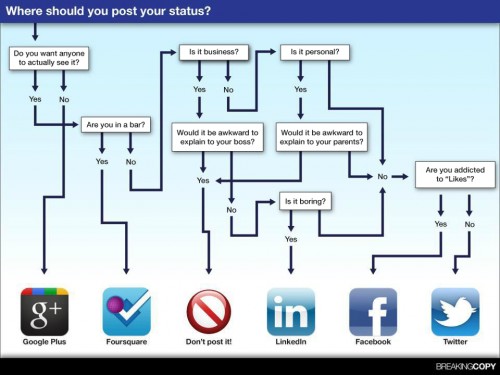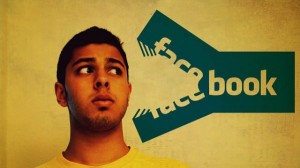
In the last part of my recent essay “A New Privacy,” I described documentary consciousness as the perpetual (and frequently anxiety-provoking) awareness that, at each moment, we are potentially the documented objects of others. In this post, I use a friend’s recent ‘Facebook debacle’ as a starting point to elaborate on what documentary consciousness is, how it works, and whether it can be diminished or assuaged by the fact that “nobody… wants to see your status update from 2007.” I draw on Brian Massumi’s distinction between the possible and the potential to help explain why documentary consciousness entails “the ever-present sense of a looming future failure,” whether anyone reads that old status update or not.
My friend Dani (not her real name) recently moved 2000 miles away to be closer to her partner. The weekend before the movers came, Dani had a going-away party at her house that featured a cookout, friends’ bands playing live, and another friend DJing after the bands’ sets. The event started at 2pm and, somewhat amazingly, managed to make it to midnight before a uniformed gentleman arrived to announce that the hour for outdoor merriment had passed. Dani chose to look on the bright side of things, and saw getting shut down by local law enforcement as just one more sign that the night had been a success. As she posted to Facebook as the officer walked away, “Hey! At least the cops shut down my party! Yeah!!”
Much later that night, Dani suddenly remembered that certain members of her extended family (with whom she has contentious relationships) were “friends” with her on Facebook; these relatives would be scandalized if they saw her status update. Dani jumped out of bed, went to her computer, and deleted the digital residue of her earlier exuberance. In reloading her Facebook profile, however, Dani saw just how many of her friends had also excitedly posted either about how the party ended or about her consequent jubilation. She started to panic at the sheer volume of documentation: well-meaning friends had not only posted on her wall, but also tagged her in a flurry of their own status updates and posted photographs. Due to a difference in time zones, it would be impossible for Dani to remove all the tags before her relatives began to arrive at work and sit down at their computers.
Then Dani had an idea: she’d simply block her relatives on Facebook instead. That way her relatives wouldn’t be able to view any of the information on her wall; she could go back to bed, and decide which posts to “un-tag” herself from next day.
The problem, as Dani explained a few nights later, was that she hadn’t realized “blocking” someone on Facebook also entails “unfriending” that person—and that “unblocking” that person does not entail quietly “refriending” them. A small group of us spent an hour or more debating the question Dani now faced: should she refriend her extended relatives or not? If she left them unfriended, they would eventually discover the unfriendings (perhaps through Facebook’s “friend suggestions”); this would make them upset, and put Dani’s closer family members in awkward positions. If Dani did refriend her extended relatives, Facebook’s “friend request” notifications themselves would implicitly serve as notifications of the unfriendings; not only would the relatives be upset, but Dani would also have to manage the family fall-out now. She asked us to come up with a plausible story—maybe about her account getting hacked—to feed the relatives about why they had been unfriended, but no one story passed muster with all of us. Dani admitted that she didn’t want to be “Facebook friends” with those relatives anyway, but felt an obligation to her closer family members to maintain digital connections with the others.

Dani’s story illustrates a number of concepts and ideas that I’ve been thinking about recently, most of which will be familiar to regular Cyborgology readers. First and foremost is the fact that “online” and “offline” are not separate worlds: online and offline relationships impact and shape each other, and frequently blur to the point of being simply “relationships” that include both online and offline interaction. Digital dualists (those who believe online and offline are separate worlds or realities) would do well to observe the very real effects that Dani’s offline activities had on her “online relationships,” as well as the effects her online activities were poised to have on her “offline relationships.” They might note as well that five people spent an hour discussing—offline and in real, live, Turklesque “face-to-face conversation”—what one of them should do to manage her online connections. Dani’s story also highlights the way family expectations can shape our use of digital social technologies (see Jessica Roberts’s [@jessyrob] presentation as part of TtW2012’s “Logging off and Disconnection” panel), and the “laborious practices of protection, maintenance, and care” that social media users put into presenting themselves online. It highlights, too, how Facebook can transform one’s friends into a form of digital paparazzi, especially for the majority of Facebook users who haven’t memorized all the ins and outs of Facebook’s constantly shifting privacy settings.
What I want to focus on, however, is the moment of panic Dani felt when she confronted the plethora of posts her friends had made about the party. Though her anxiety was sparked by being not a potentially documented object, but a clearly documented one (perhaps we would call her experience “documentary awareness”), at the heart of her disquietude was the same “looming sense of future failure” that characterizes documentary consciousness. Though each variable had a smaller range of values, she was attempting to calculate the same unwieldy and incalculable matrix of who might see which documentary artifacts, at which times, in which contexts, with what kinds of reactions, and with what kinds of consequences.
One might argue—as have Nathan Jurgenson (@nathanjurgenson) and PJ Rey (@pjrey), among others—that for most of us, the likelihood of anyone reading any particular status update we post is very small, particularly if that status update is in the past; even in the present, “the web… still sometimes forgets.” This is because the so-called ‘data deluge’ is not limited to corporations and researchers; it is also alive and well in ordinary people’s experiences with social media. How many Facebook users have all of their Facebook ‘friends’ in their newsfeeds, and how many Facebook users actually read every newsfeed item that appears? For an ordinary Facebook user, who’s going to comb through each and every status update to find the incriminating one, whether it was posted three days ago or three years ago?
Like jokes about “at least it was on G+ where no one will see it,” these arguments rest on the assumption that though it may be possible for someone to view incriminating content, the probability that anyone will do so is really very low for most social media users. Fallout from something as mundane as a single status update is therefore only a very small possibility, and not one worth getting worked up about. We may like to think that we are all special, unique snowflakes, and that “everything we do is being recorded for all time,” but no: snowflakes melt, and so do their status updates, usually without incident (or accolade).

What fuels the anxiety of documentary consciousness, however, is not possibility, but potentiality. In his book Parables for the Virtual, Brian Massumi draws on philosopher Henri Bergson to explain the difference between “the possible” and “the potential” through the image of an archer’s arrow shot into the air. While the arrow is in flight, there exists an infinite array of positions that it could occupy in any next moment; the continuity of movement that we see in the arrow’s flight path can only be measured and confirmed once the arrow comes to rest (whether in a target, in the ground, or off in the bushes somewhere). While the arrow is in flight, all points in space are its potential endpoints; when the arrow comes to rest, and its “real trajectory” is known, the range of its possible endpoints can be plotted retrospectively by tracing backward from where the arrow’s flight ended. Possibility is therefore “back-formed from potential’s unfolding.”
If we consider any given digital artifact on Dani’s Facebook profile to be the arrow, and its ultimate impact (or lack thereof) the place where the arrow lands, we start to see why potentiality is the key to documentary consciousness. When has a tag, a photograph, or a status update “come to rest”? Even if it registers a bullseye in the target of an angry relative, there are still more relatives; a status update’s flight path can switch seamlessly from digital to analogue (and back again) through word of mouth, through family gossip, through online and offline confrontations. Even if a photograph is deleted, it may have been saved or copied by someone else; though one version’s flight path may end at uneventful deletion, countless others may still be in flight—and we can know neither their possible numbers, nor their possible impacts, until they land.
Massumi states that once possibility is formed, it feeds back in to prescript a normative range of outcomes. In Dani’s case, this range probably includes a large number of outcomes in which nothing in particular comes of her status update, and only a few outcomes in which she experiences fallout (after all, the risk—though real—is small). But the problem is that the flight path of a digital artifact never fully stops unfolding, so the range of possibility is never fully formed. Potential, Massumi writes, “is the immanence of a thing to its still indeterminate variation, under way.” Digital artifacts cannot escape the unprescripted realm of potentiality, and the potential “only feeds forward, unfolding toward the registering of an event.” It is these unknowable, unregistered events that ‘loom’ when we experience documentary consciousness.
In short, the magnitude of possibility is not the issue here. It is not possibility, but possibility’s indeterminacy, that drives our anxieties about the unknown and unknowable futures of our digital artifacts.
Social media flowchart from https://plus.google.com/115389785798978799745/posts/F3SadyEuQS1
Facebook eats man image from http://www.funfused.com/signs-facebook-stalkers/
Archery targets image from http://bullseyearchery.info/tag/archery-information/

Comments 5
In Their Words » Cyborgology — July 29, 2012
[...] “the flight path of a digital artifact never fully stops unfolding, so the range of possibility is ne...” [...]
test post one! | Studio PucelleStudio Pucelle — November 15, 2012
[...] of too many reasons to avoid it. Silly and self-defeating, right? Between classmate trolls and potential future ruin, trying to maintain a blog made my head spin and heart race! Ugh! Good riddance to all that [...]
touch + sight | celebrate your senses — November 16, 2012
[...] of too many reasons to avoid it. Silly and self-defeating, right? Between classmate trolls and potential future ruin, trying to maintain a blog made my head spin and heart race! Ugh! Good riddance to all that [...]
Let Sleeping Memories Lie: High School and the Facebookless Past » Cyborgology — November 29, 2012
[...] aside, I’m probably the only person who’s ever read any of that stuff in its original format. Facebook Timeline, on the other hand, is collaborative; it’s not just me telling my story, it’s everyone who uploads a picture or tags me in a post or [...]
From Pinterest to the Prison Industrial Complex » Cyborgology — December 12, 2012
[...] and cultures in unknowable ways. In other words, technology is imbued with vast and complex potentialities. The purpose of Pinterest is the recreational sharing of interests, consumables, crafts, and [...]